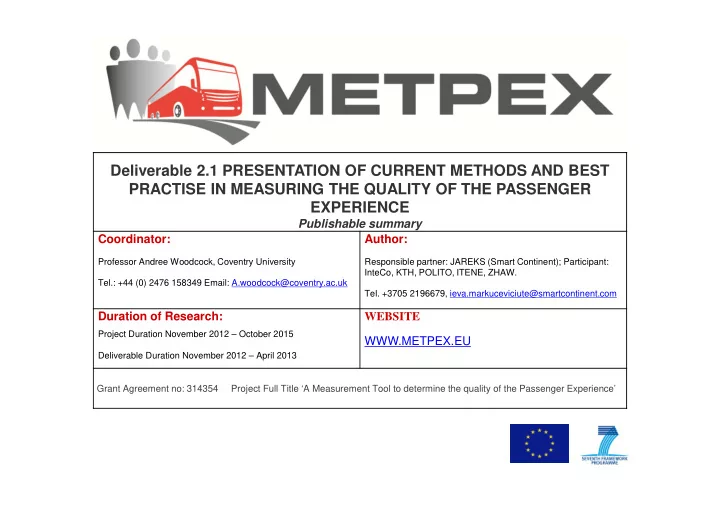

Deliverable 2.1 PRESENTATION OF CURRENT METHODS AND BEST PRACTISE IN MEASURING THE QUALITY OF THE PASSENGER EXPERIENCE Publishable summary Coordinator: Author: Professor Andree Woodcock, Coventry University Responsible partner: JAREKS (Smart Continent); Participant: InteCo, KTH, POLITO, ITENE, ZHAW. Tel.: +44 (0) 2476 158349 Email: A.woodcock@coventry.ac.uk Tel. +3705 2196679, ieva.markuceviciute@smartcontinent.com Duration of Research: WEBSITE Project Duration November 2012 – October 2015 WWW.METPEX.EU Deliverable Duration November 2012 – April 2013 Grant Agreement no: 314354 Project Full Title ‘A Measurement Tool to determine the quality of the Passenger Experience’
Summary & Purpose of D 2.1 Deliverable D 2.1 – Presentation of current methods and best practice in the measurement of the quality of the passenger experience – is part of METPEX project activities. D 2.1 is the outcome of Task 2.1: Identification of current methods and best practice in measuring the quality of the passenger experience. Main objective of the deliverable was identification of the state of the art concerning the quality measurement indicators and methods of door-to-door passenger experience through desk research and analysis of the existing literature (European and national related standards, studies, indicators and methodologies)
Approach and methodology D 2.1 was produced by using Desk research as the main technique. Desk research is a method to acquire basic information on state of the art of the research object and to benchmark further research process. Following information resources were used to D 2.1 report: • Online resources – results were gathered by using search engines to find results for keywords such as passenger experience, passenger experience measurement, best practice in passenger experience measurement, passenger satisfaction, travel experience, public transport experience, etc. • Research paper database – dedicated scientific databases were browsed using METPEX relevant keywords (please see previous paragraph) to identify approaches and methodologies of passenger transport quality evaluation. • Government institutions published data – passenger transport and transport policy dedicated websites published by EU.
Findings Analysis revealed that a limited set of variables is used to evaluate passenger experience. Different survey methods use different combinations of mentioned variables. The most common survey methods are interviews and questionnaires. Same variable may have different definitions, e.g. geographical and physical accessibility. Also, indicators may be basic and advanced: • Basic quality indicators that define lowest acceptable level of service. • Advanced quality indicators that define level of transport service comparable to comfort of using private vehicle.
Research results Following indicators were identified as the most common and relevant Accessibility to describe passenger experience: Safety Security Environmental impact • Accessibility • Price Reliability • Safety • Safety Flexibility Speed • Security • Integration Frequency Price • Environmental impact • Attractiveness Safety • Reliability • Passenger right protection Information Integration • Flexibility • Smart tickets Attractiveness • Speed • Comfort Feedback Passenger right protection Smart tickets • Frequency Comfort Feedback Following methods were identified as the most common to gather passenger experience: • Surveys and polls • Benchmarking
Conclusions & Further Study D 2.1 results will be used to develop METPEX tool in further project activities. Main deliverable conclusion are as follows: • The data about passenger experience is gathered using common methods across different groups; • The gathered data about passenger experience is either used for benchmarking, comparative analysis, comparison with the standards and minimal requirements; • Service providers and government institutions practice benchmarking and comparison with the standards (in government case meeting minimal requirements) of data gathered about the passenger experience.
Recommend
More recommend